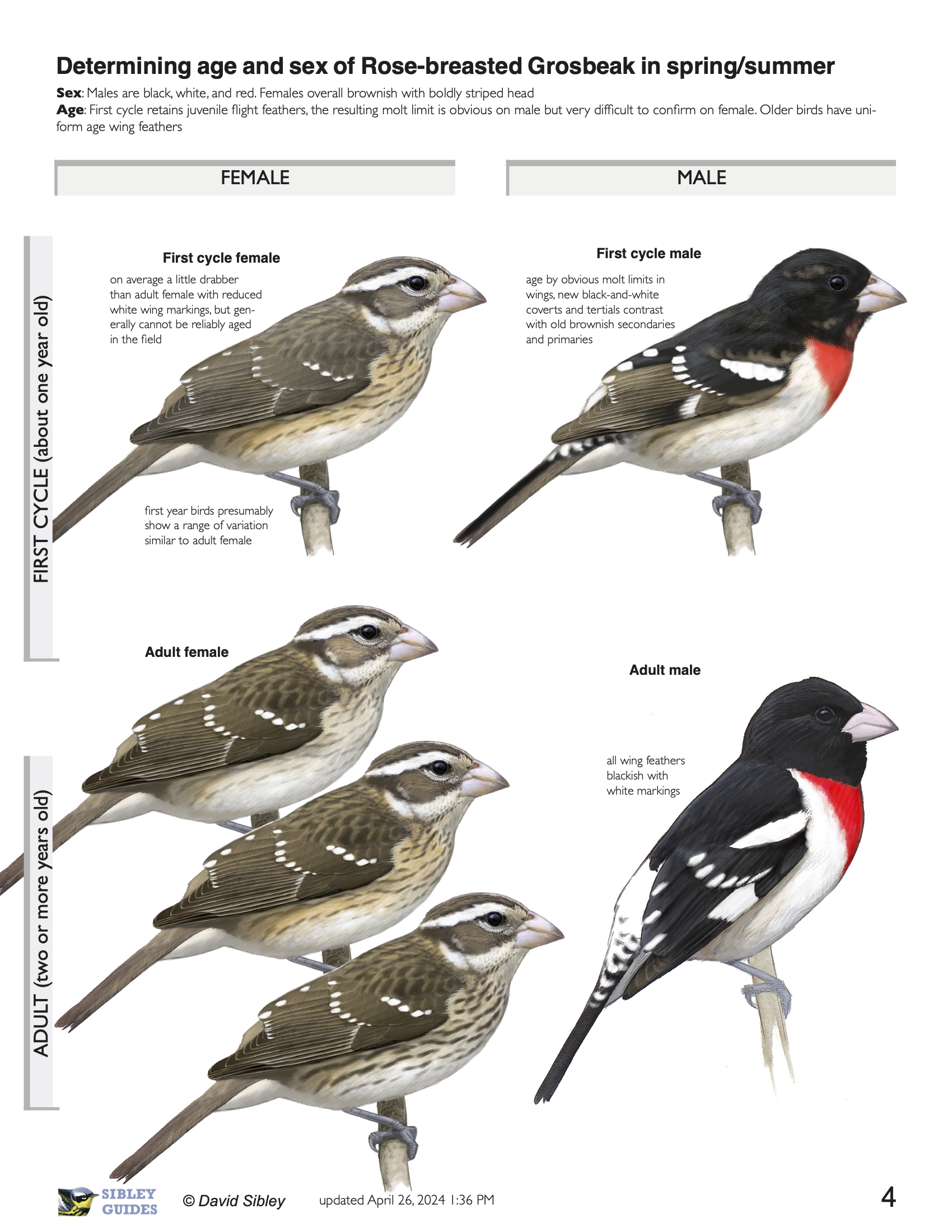I put together this matrix of variation in breeding plumage Rose-breasted Grosbeaks, showing the differences between each of the four age-sex classes. In this species it’s relatively easy to distinguish males from females, a little harder to distinguish one-year-old males from older males, and nearly impossible to determine the age of females.
As in many songbirds, the key to aging is to look for the more worn, faded, and drabber wing feathers retained from juvenile plumage (grown in the nest the previous summer). These feathers contrast with the more recently grown wing covert feathers and innermost tertials.
Also like most songbirds, we can’t determine the age of a Rose-breasted Grosbeak after its first year. They replace all of their feathers in late summer in a complete molt, and from that point on are in the “adult” cycle and look essentially the same for the rest of their life.
Link to a one page pdf



This is a great resource, thank you!
Do you know if males keep their summer plumage all year round or molt on their breeding grounds? I’ve been wondering about this for quite some time.
Males molt in late summer into a slightly drabber winter plumage, with black-and-white wings and a rosy breast but most of the feathers have brownish fringes. They don’t molt again in spring. The pale brownish feather edges simply wear off by spring to reveal the clean black of the spring/summer plumage.
Reviewing some images of adult male Rose-breasts from Feb-March in Macaulay, I believe I see evidence that they do indeed molt at least some body plumage to change from basic to alternate plumage. For example:
https://macaulaylibrary.org/asset/210241031
https://macaulaylibrary.org/asset/143388681
https://macaulaylibrary.org/asset/47938431
https://macaulaylibrary.org/asset/51751641
https://macaulaylibrary.org/asset/214073111
https://macaulaylibrary.org/asset/112927611
https://macaulaylibrary.org/asset/146161191
https://macaulaylibrary.org/asset/139051741
https://macaulaylibrary.org/asset/52914681
https://macaulaylibrary.org/asset/49283981
https://macaulaylibrary.org/asset/616748115
https://macaulaylibrary.org/asset/85539071
And additional adult males show extensive “female-like” facial patterning that I would be surprised is retained into the following spring (based on samples of birds in the double-digits at my feeders, aged by wing and tail, the males with retained female-like facial patterns are inevitably 1st basic). Such as:
https://macaulaylibrary.org/asset/146321191
https://macaulaylibrary.org/asset/204841881
https://macaulaylibrary.org/asset/145503341
https://macaulaylibrary.org/asset/418281321
https://macaulaylibrary.org/asset/51181641
I should check the LSU collection to see what molt is present on birds from Feb-March, perhaps I can do that tomorrow. In any event, I am quite certain that adult male Rose-breasts do indeed molt head and back contour feathers, at least, with many adopting a “female-like” plumage in basic definitive (belied by the all-black wings and white tail spots), and this plumage has been rampantly mis-aged by many observers, including those who have produced reference materials.
Nice work. Now, something like this for autumn aging and sexing is necessary! I believe most folks misidentify many adult males in basic plumage as 1st cycle males because they look at the “female-like” body plumage and ignore the wings. This mis-aging is rampant in reference material (eBird’s species webpage, Birds of the World, and several other references), and as a result, many birders relying on these references are misled.